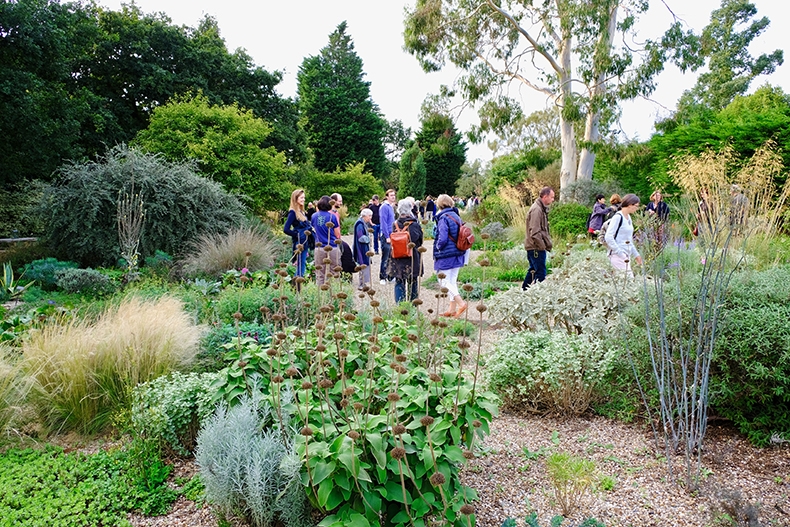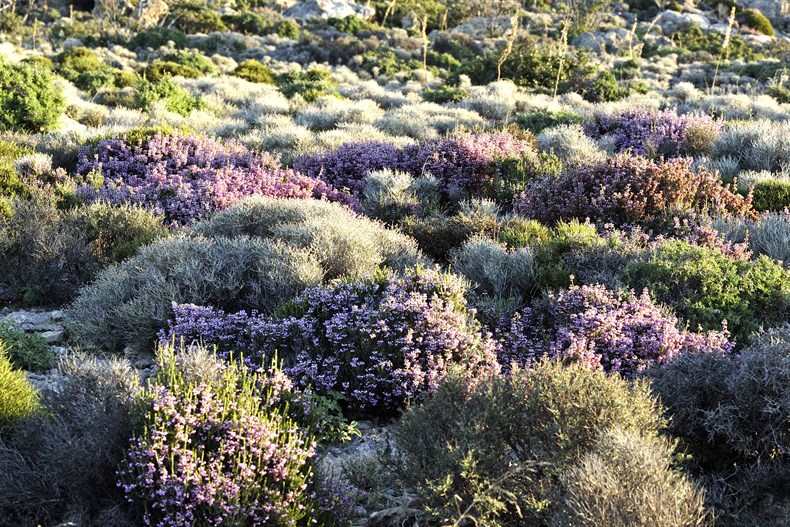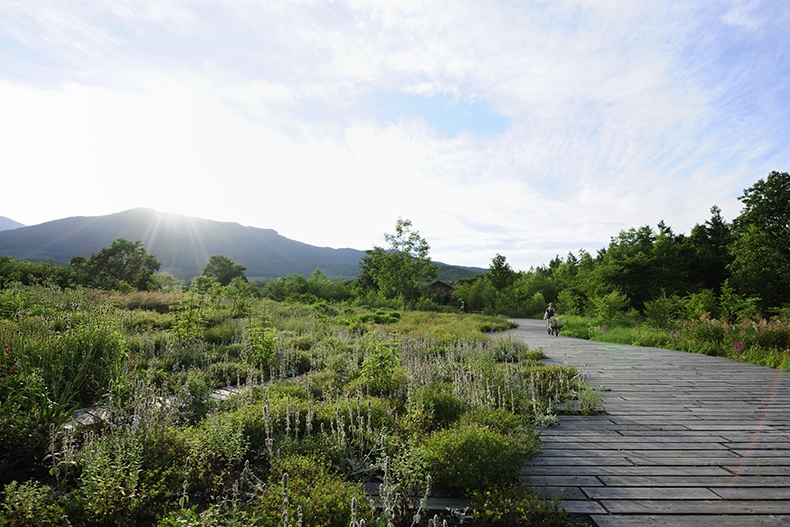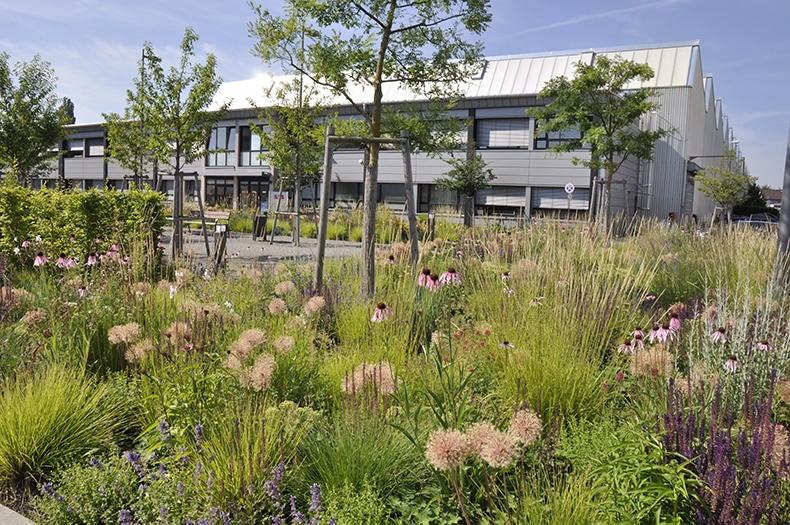
Delegates of the symposium spent an evening at the Beth Chatto Gardens
Darryl Moore sumarises speaker highlights from the recent event
The Beth Chatto Symposium: Ecological Planting in the 21st Century, took place on 30-31August 2018 at the University of Essex, Colchester.
When Brita von Schoenaich and Tim Rees organised a conference at Kew in 1994, looking at new planting styles in Europe, little did they know the effect it would have. The event was instrumental in heralding in what became known as the New Perennial movement, something that in the intervening years has spread globally and become ubiquitous among designers and gardenistas. Having now reached ‘peak Piet’, the timely occurrence of the symposium Ecological Planting in the 21st Century may just well prove to be the next seminal moment in the gardening world, moving planting beyond New Perennial borders towards new horizons.
Organised by the Beth Chatto Education Trust, the two-day event was a fitting tribute to Chatto, who died earlier this year while it was in planning, and was intended to mark her 95th Birthday and 40th Anniversary of the publication of her game-changing book ‘The Dry Garden’.
Gathering together 500 people from 27 countries, the symposium revealed the extent to which different ideas about ecological planting have been rhizomatically spreading through the gardening underground in recent years. While different practitioners have been ploughing this furrow in their own fields for some time, the symposium brought many of them together under one roof to provide a useful snapshot overview. As speaker James Hitchmough playfully suggested, those present were members of a cult, one whose members are pushing Chatto’s legacy in new directions, under the guiding mantra of ‘right plant, right place’.
Distinguishing itself from the naturalistic aesthetics of the New Perennial style, ecological planting is defined by the nuanced layering of plants in dynamic communities rather than in massed colour-coordinated blocks. It digs deeper into natural processes, plant associations and relationships in wild habitats, learning from nature in order to understand how and why plants perform in the ways that they do.
Aiming as it does to create designed schemes that fuse both scientific rigour and visual clout, ‘Eco Aesthetics’ would be an apt moniker to apply to this burgeoning movement, the diversity and different strands of which were well represented by the symposium speakers.

Photo: Oliver Filippi
Hitchmough has been at the forefront of research developments through his work at the University of Sheffield, which has proved a fruitful testbed for new planting ideas in the urban realm. He delivered two presentations, book-ending the proceedings, the first preparing the ground for the other speakers, discussing the pros and cons of the approach, and the second looking at the results of his own explorations, methods and trials.
He outlined ecological planting as the creation of designed plant communities along a gradient from tame to wild, with myriad potential positions in between. Considering planting patterns, species diversity and biomass capacity, Hitchmough questioned certain assumptions about the benefits of ecological planting over ornamental horticulture, suggesting that it is often a Faustian tryst, trying to balance benefits that can tend to negate each other. He proposed that the successful function of planting schemes can be measured by the resilient capacity of plants to survive in the long term and the ability of communities to resist weed invasion.
While stressing the importance of observing plants in the wild, he also asserted that the cultural nature of designed schemes, means that they need to address the needs of the people who experience them, encouraging designers to “manufacture joy” through embracing exuberance and colour. Citing a number of his projects including his work at the Olympic Park, he advocated growing from seed in-situ, in low-nutrient mediums, rather than establishment by planting, adamant that such an approach produces more successful results.
With a background in both landscape architecture and horticulture, Cassian Schmidt presented the work he has overseen as Director of Hermannshof Garden in Germany over the past 18 years - the organisation responsible for developing what was known as the New German Style in the 1990s, and for trailing and analysing perennial plant communities for use in public spaces. Describing Richard Hansen’s pioneering work at the Trial Garden at Weihenstephan and his ideas about plant habitats and sociability, Schmidt discussed the development of these within this own work, and his interest in the sustainability and maintenance of plant communities.
Looking at facts concerning stress tolerance and competitiveness, he presented analysis on the annual effort required to maintain various types of planting, which revealed ecological schemes to be less labour intensive than more traditional styles. The methodical hard data he presented was impressive, and useful for designers wishing to convince those that control public purse strings of the economic value and benefits of the ecological approach.
While the other speakers discussed planting in temperate climates, Olivier Filippi came at the topic from a different direction, presenting his forays into the flora of the Mediterranean. He shared how gardening in such a distinct climate with its unique woody and lignotuber plants came with a unique set of challenges, including herbivore disturbances, fire, prolonged heat and drought, short herbaceous spring periods and the anti-social antics of allelopathic plants.
Filippi displayed his own garden where he has been experimenting with ways to work symbiotically with local and regional plants, relating the process to techniques used in agro-forestry management. His assertion that “We don’t want artists, we want ecologists”, stressed that designers working within this biome need to prioritise their knowledge rather than their creative skills, in order to create sustainable schemes. His presentation was well illustrated with images of work by regional designers and gardeners including Thomas Doxiadis, the practice Urquijo-Kastner, Jennifer Gay and Piers Goldson, Agence APS and Bruno Demoustier.
While most ecological approaches prioritise finding plants to suit existing conditions, plant obsessives Keith Wiley and Peter Korn have turned the tables. Determined not to be fettered by the conditions they have found themselves confronted with, they have instead both chosen to dramatically transform their landscapes in order to grow the flora they most admire.

Dan Pearson and Midori Shintani spoke about Tokachi Millennium Forest in Japan.
Wiley was Head Gardener for 25 years at The Garden House on Dartmoor before establishing his Wildside nursery and garden in Devon in 2004. His presentation took a personal trip through the earthwork escapades of constructing and developing Wildside, transforming a featureless four-acre, former cider-apple orchard into a veritable botanical theme park, inspired by his global travels observing plants in their native habitats. After initially performing the Herculean task of removing all the topsoil from the site and replacing it with acid loam and schist, he then mounded hills, sculpted slopes, shaped valleys and created ponds, in order to create a diverse range of aspects and microclimates to accommodate his wide ranging collection of plants from South Africa, Colorado and Crete. Whist it would have been interesting to hear about the sustainability credentials of such an endeavour, the work certainly exemplified dedication to the extreme end of the spectrum of matching plants with place.
A similar fascination with plants was clearly evident in plantsman Korn’s account of developing a nursery and constructing his garden. His addiction to plants from hot regions has driven him to grow a formidable collection from seed, and his singular determination has lead to the astonishing achievement of establishing them in his garden in Sweden. His approach strives to create the conditions that plants from Kyrgyzstan and the western United States would normally grow in. By stripping back his plot to expose it to more light and the elements, he has created the harsh conditions necessary to keep the plants hungry, hardy and happy. His anecdotes about running a nursery business, from which he uses most of the plants himself, provided a humorous sense of self reflection, endearing to the audience.
Peter Janke’s presentation was also focused around the creation of his own garden, Hortvs in Hilden, Germany, as well as some of the projects he has created as a designer. On the gradient between wild and tame he veered towards the latter, placing an emphasis on the aesthetic effects of plant placement, yet still guided by the principles and skills he picked up working as a volunteer for Beth Chatto back in 2003/4. He reflected upon the cultural legacy of Modernism on German gardens and on the need to translate avant garde ideas into ordinary gardens by striking an appropriate balance between formality and the random appearance of natural vegetation.
Dan Pearson MSGD was an obvious choice for the event, being a long time friend of Chatto, originally encountering her at the age of 12 at the RHS Chelsea Flower Show. Ever since he has taken inspiration from her ideas into new dimensions with his distinct and distinguished work, as evidenced in the selected portfolio projects he displayed. Lowther Castle, Maggie’s Centre Hammersmith and the Garden Museum all received an airing, but the main focus of his talk involved drilling down into his master work at the Tokachi Millennium Forest in Hokkaido, Japan. He explained the garden’s incredible brief to create a garden to last for 1,000 years, its inception and development, and his ongoing relationship with it, involving annual visits. The details highlighting how the project stands alone as a master class in long-term thinking about the relationship between people and plants.
This dovetailed nicely into a presentation by the Tokachi Millennium Forest Head Gardener Midori Shintani, who provided a complementary mirror to Pearson with her view of their important association, as well as discussing how she and her team endeavour to develop the project’s overarching vision. Practical considerations were discussed including the progressive clearance of invasive Sasa bamboo and the need to encourage snow thawing at the end of long winters in preparation for visitors, by scattering charcoal on the white surface to attract sunlight and warmth. She culturally contextualised the approach to the garden as one of harmonious co-existence, relating it to various Japanese sustainable natural landscape practices such as satoyama agroforestry methods, and how the nuanced idea of 72 microseasons plays a role in working attentively with dynamic landscapes.

Speaker Cassian Schmidt's mixed perennial planting at ABB company, Ladenburg
Maintenance, rather than planting, was also the main focus of Andi Pettis, Director of Horticulture at the High Line. Detouring from the event’s ecological theme, she took the audience on a tour through the teething stages of the park and the operational challenges faced by the team tasked with keeping it looking attractive to the millions of people who visit it each year. Anecdotes reflected how logistics have been sorely tested when initially trying to remove the previously unanticipated amounts of rubbish that accumulated on the elevated park, adding additional soil and organic matter by crane, as well as when the underground control room flooded. Her seasonal trek through the necessary work of pruning, replanting, composting and clearing paths in the snow all received due attention, providing food for thought as to the amount of effort required to keep such ambitiously sized projects running smoothly.
In lieu of question and answer sessions after each presentation, a series of panel discussions were scattered throughout the proceedings, featuring various combinations of the speakers as well as Beth Chatto Gardens Head Gardener Åsa Gregers-Warg and nurserywoman Marina Christopher. Topics under discussion ranged from maintenance, challenges for nurseries, the garden media and the balance between inspiration and information in the design process. Opportunity for discussion between speakers and attendees was fostered at an evening soiree, fuelled by food and drink in the suitable environs of Beth Chatto Gardens.
The symposium reflected the diversity of approaches thriving within this ecological turn in gardening, while reinforcing the central thesis of appreciating plants holistically and as part of dynamic interactive systems, rather than simply for their flowers. The questions raised and apparent consequences of the approach surely suggest a follow up event would be a good (and popular) idea.
This could afford the opportunity to unpack the potential opportunities of plantings featuring not just perennials but also shrubs and trees, as well as digging deeper into soil science and bacteria, and discussing in depth the new skillsets needed by designers and gardeners.
The cult of Eco Aesthetics has convened, sowing the seeds for ecological planing to spread its roots into the gardening mainstream. Now it’s time to watch it grow.